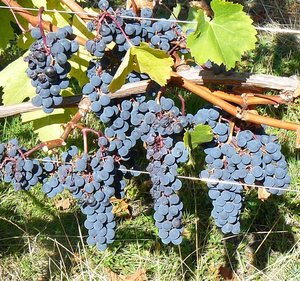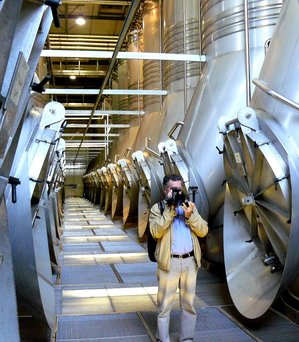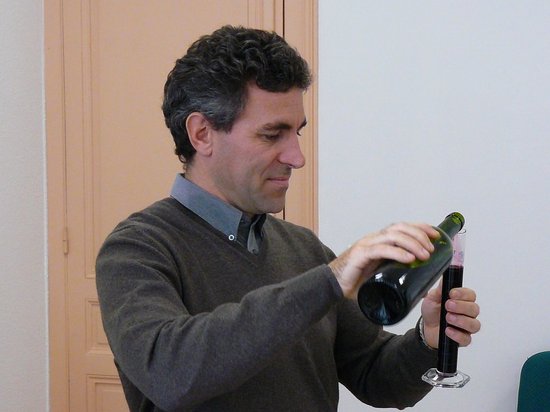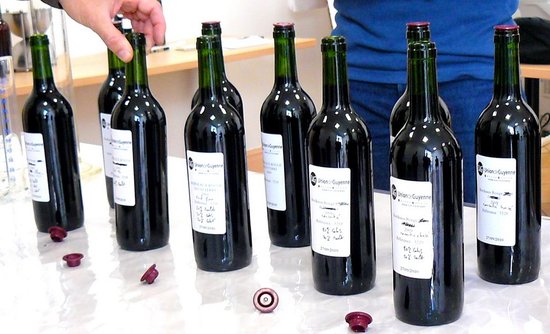SAUVETERRE DE GUYENNE -- Holding the beaker is enologist Philippe Cazaux, general manager of the giant wine-making cooperative here, a medieval market town in the heart of Bordeaux country. Not one of the prestigious châteaux of the Médoc (a region that has its own very fine coop, thank you), but in the Entre-Deux-Mers, a vast swath of woods and vineyards studded with relatively modest 10-acre properties.
They say it takes great humility to make wine, to accept as gracefully as possible the fruits of the growing season for the grapes of your vineyard. At least they say it in Burgundy, where they plant either pinot noir or chardonnay, and have no recourse to other grapes if it's too hot, too cold, too damp or too dry. They also say that it to make wine in Bordeaux takes genius, because you have half a dozen grape varieties to worry about, each with its attributes, diseases, flavors and flaws. Winemakers in Bordeaux are free to blend from a palate of grapes and flavors, but it's an uneasy freedom; the permutations multiply with astonishing rapidity when you factor in the result you want to achieve.
The concept of a "Bordeaux blend" is as old as these picturesque, densely planted hills. Wines, to use the French word, are "assembled" from the region's authorized varieties: merlot, cabernet sauvignon, cabernet franc, malbec, petit verdot for the reds; sauvignon blanc, sauvignon gris, semillion and muscadelle for the whites. (In American wineries, partial to bottlings of single-variety wines, they've come up with a word for wiines blended from these Bordeaux varieties, the made-up name "Meritage;" it may look kinda French but it's pronounced like Heritage.)
 Four out of every ten growers in Bordeaux (and there are some 10,000 of them, farmers with fewer than 20 acres apiece) sell their grapes to one of the region's 40 or so coops, whose bottlings, in turn, account for about a quarter of all Bordeaux produced. As one might expect, some of them simply churn out oceans of undifferentiated wine under a house label, generic Saint Emilion, for example (still pretty good stuff, as long as it qualifies for the AOC designation, and basic Bordeaux for whatever doesn't qualify). But here in Sauveterre, the Union de Guyenne has the technical capacity to take things to a higher level: making wine to order.
Four out of every ten growers in Bordeaux (and there are some 10,000 of them, farmers with fewer than 20 acres apiece) sell their grapes to one of the region's 40 or so coops, whose bottlings, in turn, account for about a quarter of all Bordeaux produced. As one might expect, some of them simply churn out oceans of undifferentiated wine under a house label, generic Saint Emilion, for example (still pretty good stuff, as long as it qualifies for the AOC designation, and basic Bordeaux for whatever doesn't qualify). But here in Sauveterre, the Union de Guyenne has the technical capacity to take things to a higher level: making wine to order.
Let's say a chain of supermarkets in the UK, or a regional group of casual dining restaurants in southern Germany, or even the Swedish liquor monopoly wants to offer its clients relatively inexpensive, easy-drinking "private label" French wine from Bordeaux. The call would go out to potential suppliers via the wine merchants who handle three-quarters all the region's sales (and there some 400 of these négociant houses in Bordeaux). The client might have any number of additional conditions: a specific price point, bottle size, flavor profile, etc. Now, where to find a winery big enough to satisfy such diverse requests? Increasingly, such custom-crushed, custom bottled wines are coming from cooperatives like Philippe Cazaux's high-tech Union de Guyenne.
 Cazaux has a team of expert enologists on his staff, who spend their time in the vineyards as well as the lab; they know each coop member's strengths and weaknesses, soils, viticultural practices and so on. This guy's merlot might fit the bill, but needs some reinforcement from that guy's cabernet, for example. In practice, it's far more complicated, since the cooperative's growersrepresent smaller vineyard holdings to begin with, and the custom orders re for more than one or two growers can supply. So not only is the challenge to blend from one property but from several.
Cazaux has a team of expert enologists on his staff, who spend their time in the vineyards as well as the lab; they know each coop member's strengths and weaknesses, soils, viticultural practices and so on. This guy's merlot might fit the bill, but needs some reinforcement from that guy's cabernet, for example. In practice, it's far more complicated, since the cooperative's growersrepresent smaller vineyard holdings to begin with, and the custom orders re for more than one or two growers can supply. So not only is the challenge to blend from one property but from several.
American drinkers, always eager to latch onto easy-to-grasp numbers, have come to understand that many of their favorite reds aren't really 100 percent cabernet sauvignon, that the winemaker has blended in a touch of merlot, say, or a touch of malbec, the way a chef might add wine or cream to a sauce. But it's one thing to whisk in a slosh of brandy before serving that veal chop, and quite another to produce a palatable blend of tens of thousands of hectoliters (that may change as it ages in bottles), to complement a regional preference for a soft-but-spicy wine to accompany a restaurant's winter promotion of wild boar (let's say--I'm making this up).
To test this notion, Cazaux invited our delegation to try our hand at blending. The assignment: to concoct, from half a dozen not-yet-botled wines, a palatable blend that would offer pleasurable drinking over the next couple of years. Merlot, the workhorse red grape in the Entre-Deux-Mers, is juicy but lacks acidity. Cabernet sauvignon is often quite tannic, while cabernet franc can give lovely aromas. Adding to the uncertainty: some of the young wines showed rather intense effects of aging in oak casks. We take notes on the samples, we guess at what might work: 50 percent of wine number one (bright red fruit), 20 percent of number two (100 percent merlot, to bring down the acidity), 30 percent of number three (mostly cabernet, for some "grip"). Cazaux follows our instructions, measures out the millilters, then judges our efforts at creating something drinkable. His comments vary from "concentrated" to "oaky" to "not ready" to "rich, round and accessible" (which turned out to be Cornichon's blend, described above, his favorite).
It's a daunting task, and I don't expecct to open my consulting business any time soon. (The last time I tried it, at the Blend tasting in Seattle last month, I found my own blend virtually undrinkable.)
How does Cazaux do it? Simple, he answers with smile. "First, bit of organization. You have to know the market. And, of course, you have to have savoir-faire, that is, technical ability, and then even more organnization."
Cazaux is too modest. There's more to this than just being "organized," as the French put it You've clearly got to be a genius.
By way of explanation to readers (and busybody federal regulators) who might wonder how Cornichon got here: our delegation of wine writers was invited and hosted by the Syndicat Viticole of Bordeaux & Bordeaux Supérieur, the umbrella organization for some 4,000 growers and their annual production of 500 million bottles of wine. Hope we didn't drink it all! Many thanks for your thoughtful planning, patient explanations and generous hospitality I raise my glass in a toast: to your health, santé!


Great one. Thanks for sharing this.